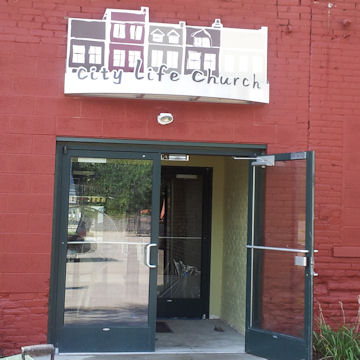
The Privilege & Responsibility of Serving: City Life Church
Adam and Cristy Lipscomb started City Life church in their living room 2006. Once they outgrew their space, their first “church building” was a public banquet hall in the downtown city bus station. In the basement of the building, the children’s ministry was behind a cloth curtain hung over the entrance of the walk-in coat room, next to a banquet room filled wall to wall with 40 to 50 people. Dianna Garrett, a drifting heroin addict who came to Grand Rapids after leaving Chicago, remembers that day like it was yesterday. “I came here not knowing my destination, and was planted in a circle of love.”
Seven years later, Dianna is on the leadership team as City Life Church, and this year they celebrated opening in a fourth location in the 500 block of Division Avenue in October. Dianna remembers that during City Life’s early years, she was in and out of the church’s sphere of influence. What kept bringing her back was Adam and Cindy’s love. Even though her oldest adult daughter had taken custody of Dianna’s two youngest children, she remembers, “They didn’t preach to me about drugs, not once. They just loved on me.” Kristy and Adam’s lifestyle attracted her, and when she began drifting through the doors regularly, Pastor Kristy found something for her to do.
Dianna remembers that when she was asked to stand on the platform, at the beginning of the weekend services, she felt connected to something. The pastors’ faith in her helped her renew her faith in herself, and find faith in Christ. Today, there are “lots of people like am and like I was,” who are active in the day to day activities of running the small church. “Nobody is shunned; nobody turned away. . . (Christy) . . . finds everyone something to do.”
This unconventional approach is an intentional way that the church lead team connects with their community. According to Pastor Christy, close to one-third of their congregation are clients of the missions which populate the Division Ave corridor. Another third of the congregation are typical, middle-class families who drive into the church, and the remaining portions of their regular congregation are in unstable life circumstances. Yet, like Jesus who regularly had dinner with the “sinners and tax collectors” of his day, City Life Church pursues a path focused on making an impact on their neighbors and surrounding neighborhoods in the His name.
City Life’s vision is “for an evangelistic, multi-cultural church serving with the poorer community” of Grand Rapids. They work hard at not creating an “us and them” culture in their congregation where one group comes to give, and another group comes to receive. One of the strategies they use is including everyone in some part of the weekend services. For the homeless mission clients who come through the doors, this means asking them to serve as greeters, or hand out bulletins. For some of those who come on a more regular basis, volunteer positions are available at the café serving coffee, or like Dianna, making announcements before the service starts.
Christy noted that intentionally serving a poorer and diverse community requires personal sacrifices. She says that too often, churches which have resources can talk about cultural racism and poverty, but don’t build relationships and pursue initiating cultural transformation. By serving the congregation at City Life, she’s learned that even though many Christ-followers aren’t racist themselves, they are unwilling or unaware of the responsibility that Jesus gives them to work toward changes. She describes that in their church’s ministry vision, the majority class in any society has “privileges and responsibility in every culture to steward reality according to Kingdom values, not personal values.”
For Pastor Christy, this means living in the neighborhood they pastor. They’ve adopted two bi-racial children, and stay connected to the children’s biological families as a way of building culturally and spiritually transforming relationships. Their example is affecting the neighborhood, and their own staff. Assistant Pastor Nathan Beals and his wife, who’ve been married only since 2008, also adopted seven children to create their multi-cultural family.
In 2010, research, the Barna group discovered that six trends are shaping the church of the 21st century. Some of these trends are building a stronger church, and others are signs of its continued disconnection to the post-modern world.[1] City Life’s intentional, multi-cultural gospel community is an example of how god’s people can connect with the culture. They are working to reverse the negative trends and leverage the positive notes from Barna’s research to build an active, faith-based community. For more information, contact City Life Pastors online through http://www.citylifeonline.net, or visit the church at 574 S Division Ave, Grand Rapids on Sunday mornings. They have a list of ways you can help.
[1] Six Megatrends Shaping the Church in 2012, (Dec 13, 2010), retrieved from: http://www.barna.org/culture-articles/462-six-megathemes-emerge-from-2010, on Jan 2, 2013